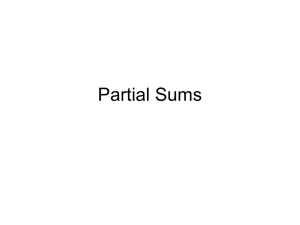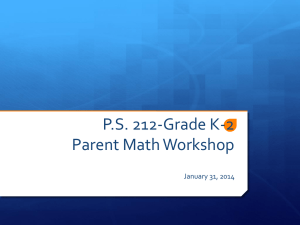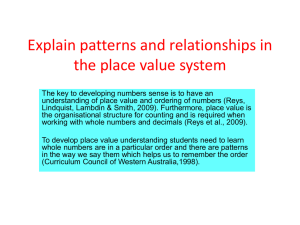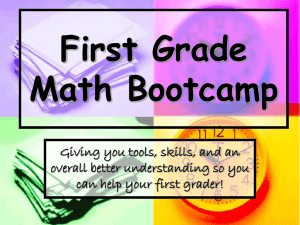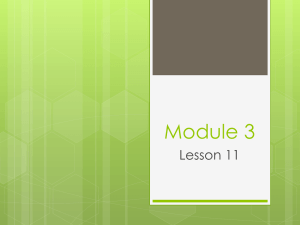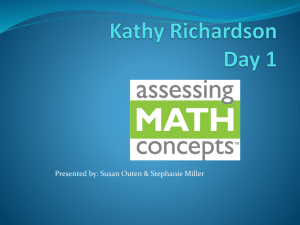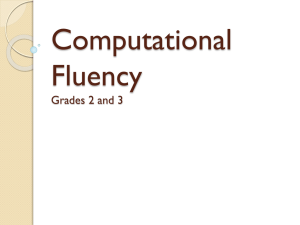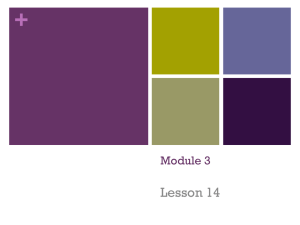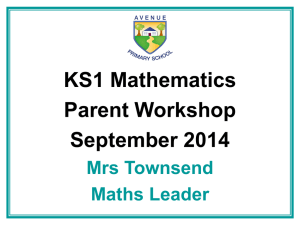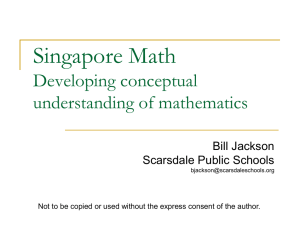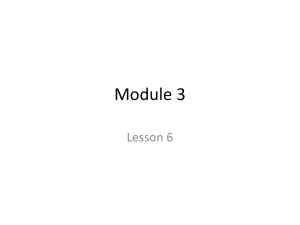RTI K.Richardson PD October 2011
advertisement
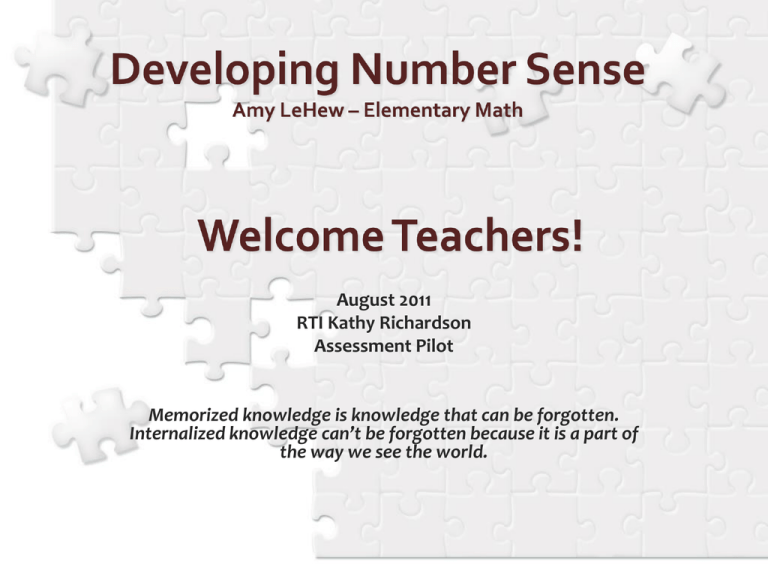
August 2011 RTI Kathy Richardson Assessment Pilot Memorized knowledge is knowledge that can be forgotten. Internalized knowledge can’t be forgotten because it is a part of the way we see the world. Amy LeHew Family Teaching (Iowa) Math Ocean How many? How many more to make ten? What does a student need to know before they can engage in this type of activity? By Kathy Richardson Assessment #5 Combination Trains Overview & Description of Strategies Learning Number Combinations • Children need to see the basic facts as a set of interrelated concepts. • Children need to be able to look for relationships between the facts they know and other larger, more complex numbers or problems. • Emphasis needs to be on learning number composition and decomposition and number relationships – not just on getting the right answers. What are we trying to determine with this assessment? To determine what number combinations the student knows and to find out if they can use the answer to a combination they know to figure out one they don't know. Does student know the parts of numbers to 10? Can student use efficient strategies to solve problems to 20. • Students will be presented with connecting cube trains of different lengths – they will be asked to add a variety of number combinations. • Will assess their fluency with numbers to 6, to 10, and to 20. Select Downloads Select Linking Assessment By Kathy Richardson Assessment #6 Hiding Assessment Overview & Description of Strategies Learning to Decompose Numbers • To subtract children need to know the parts of numbers and see the relationship between composition and decomposition. • Children must recognize that one number is contained within another number. • Children must understand that the number stays the same even when it is broken apart and recombined in various ways. What are we trying to determine with this assessment? Does the student… -know parts of numbers to 10 quickly, without counting to figure them out. Can the student… -use what they know about parts of numbers to solve subtraction problems. What Strategies do Students Use? Knows Quickly: Does not hesitate or count to figure out. Related Combinations: Uses what they already know to figure out what they don't know. Ex: I see 2. 4 and 2 is 6 so 4 are hiding. Counts On or back: Starts with what they see and counts on or starts with the whole number and counts back for each counter they see. "I see 4...So, 5...6 are hiding. Two are hiding." Counts All: Uses fingers or visualizes the whole number. Counts On or back: Starts with what they see and counts on or starts with the whole number and counts back for each counter they see. "I see 4...So, 5...6 are hiding. Two are hiding." I’ve Assessed, Now What? Assessment book Page 52 – 54 2:2-5 Book 2 Chapter 2 Activity 5 Look in Developing Book 2 – page v By Kathy Richardson Assessment #6 Hiding Assessment What questions do you have? By Kathy Richardson Should we go back? (to assessment #5) Or Forward? (to assessment #6) By Kathy Richardson Assessment #5 Combination Trains Overview & Description of Strategies Learning Number Combinations • Children need to see the basic facts as a set of interrelated concepts. • Children need to be able to look for relationships between the facts they know and other larger, more complex numbers or problems. • Emphasis needs to be on learning number composition and decomposition and number relationships – not just on getting the right answers. What are we trying to determine with this assessment? To determine what number combinations the student knows and to find out if they can use the answer to a combination they know to figure out one they don't know. Does student know the parts of numbers to 10? Can student use efficient strategies to solve problems to 20. • Students will be presented with connecting cube trains of different lengths – they will be asked to add a variety of number combinations. • Will assess their fluency with numbers to 6, to 10, and to 20. How is this different from the Hiding Assessment? . By Kathy Richardson Assessment #7 Ten Frames Overview & Description of Strategies Learning about Numbers as One Ten and Some More • Understanding that numbers are made up of “ten and some ones” is a foundational skill students must learn to work with larger numbers. • To solve more challenging problems student must move beyond counting on strategies and be able to solve problems by using relationships and understanding the underlying structure of numbers to 20. What are we trying to determine with this assessment? To determine if the student can combine single digit numbers by reorganizing them into a 10 and leftovers. To determine if the student can use their knowledge of the parts of numbers to 10 to subtract numbers up to 20. Using ten frames, students answer a series of addition and subtraction questions. Assesses whether students know parts of numbers and can break numbers apart to complete the ten to solve the problem. To complete assessment, students solve “what if” questions without the support of the ten frame. Adding Ones to a Ten (10 +9 and 6 +10): Trying to assess if student can easily add the ones to the ten without counting on or counting all. These strategies are self-explanatory. If “N” assessment will end. Part 1, Addition continued Knows Parts of Numbers Making a Ten and Adding Ones 8 + 7, 7 + 6, 8 + 5 Recognizes Ten More 18 + 5 • To determine if the student can decompose a teen number into a ten and leftovers. • To determine if the student can subtract by breaking up a number in order to get to ten and then subtracting what is left from 10. • Practice Problem: 12-3 By Kathy Richardson Assessment #8 Grouping Tens Overview & Description of Strategies Learning about Numbers as Tens and Ones Children need to learn that numbers to 100 are composed of groups of tens and ones. Children must do more than label the digits in a number – they must understand that numbers are organized into groups of tens and ones. Children must recognize that a ten is both one ten and ten ones. This level of thinking is difficult for young children. What are we trying to determine with this assessment? Do students understand that numbers to 100 are organized into groups of tens and ones. Can they add tens without counting. Can they take away tens without counting. Do they understand that counting by groups doesn’t change the total quantity? • Students will be asked to identify tens and ones when presented with number cards. Note: Number cards available under downloads of www.amcanywhere.com. • Using counters, student will identify groups of ten and leftovers. • Student will use what they know about tens to find out how many altogether. • Students will be asked to add and take away tens without counters. • Video: 33:20 • First Grader and Second Grader: 33:50 – 37:10 • 40:12 Tad Second Grader • By Kathy Richardson Assessment #9 Two-Digit Addition & Subtraction Overview & Description of Strategies Learning to Add & Subtract Two-Digit Numbers • Students must understand the underlying math to solve two-digit addition & subtraction problems – otherwise they will simply be following a procedure. • They must have a solid understanding of number relationships, number combinations to ten and numbers as tens and ones for two-digit addition & subtraction to have meaning for them. • Children must have repeated practice combining, separating, and regrouping numbers. What are we trying to determine with this assessment? To determine if the student can use the concept of tens and ones to add two-digit numbers, by mentally breaking them apart and reorganizing them into a total number of tens and ones, when the problem is presented 1) using models 2) with the model covered and 3) symbolically Students will be asked to solve a series of two-digit addition and subtraction problems. They will be asked to solve the problems by grouping/regrouping the numbers into tens and leftovers. They will be asked to use models appropriately to show their thinking, and they will be asked to solve the problems without models. Present a variety of two-digit problems to student: • • • Solves Problem with Model – showing trains of cubes Solves Problem w/out Model – cover cubes with paper Solving Symbolic Problems – use equation cards Assessment is capturing student’s answers, their strategies for solving the problems and their use of the models. Equation Cards available in the Downloads section of www.amcanywhere.com Knows parts to make/adds ten: Student easily forms tens; knows parts of numbers without having to figure anything out. Counts to make/add ten: Student can form tens and leftovers, but not automatically and still needs to figure them out. Visualizes written problem: Trying to solve problem using standard algorithm. Strategy Unknown: Prompts teacher to ask “How did you think about that?” Counts all or on: Student still thinks of numbers as a collection of units (rather than tens & ones) and counts all or on to get answer.
